Classic Callback: PAPER MARIO: THE THOUSAND-YEAR DOOR
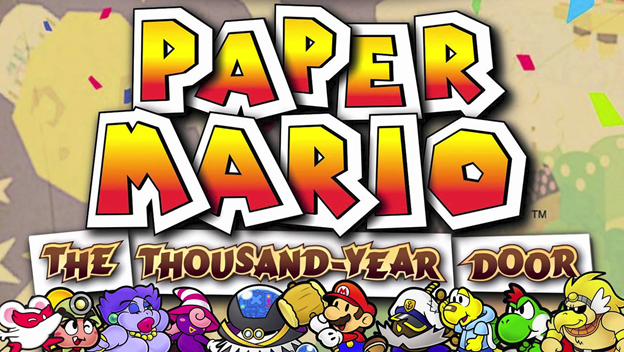
It’s no surprise that I am an avid gamer. As an only child, I had a lot of time on my hands, but not many people to spend that time with. Games filled the time for me, giving me a lot of friends along the way. Granted, those friends were generally part of the game itself, but that never really mattered. They were always there when I needed them—I just had to throw in a game disk, load up the game, and hang out. In these scenarios, more often than not, my game of choice, or, I guess, franchise of choice, was Mario. When I play Mario, I am always greeted with a focus on fun, levity, and player freedom that I do not often find in other games, though I probably wouldn’t have put my love for Mario in those words when I was five.
Throughout his run as a character, Mario has held many jobs. He is a jack of all trades, or more aptly in light of SUPER MARIO ODYSSEY, a man of many hats. As a baseball player, a plumber, a tourist, or even a cat, Mario has the ability to shape himself into any form he needs. No more useful is this skill then during Mario’s time spent as a literal sheet of paper in the 2004 RPG by Intelligent Systems, PAPER MARIO: THE THOUSAND-YEAR DOOR.
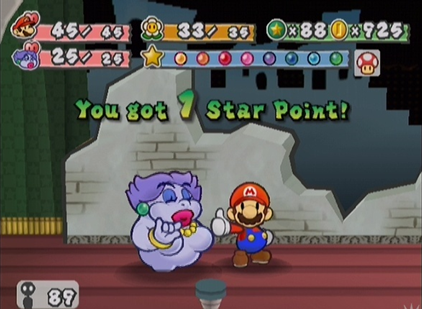
No Mario. You’re the star
PAPER MARIO: THE THOUSAND-YEAR DOOR is undoubtedly my personal favorite in the Mario series. Don’t get me wrong, I love them all, but THOUSAND-YEAR DOOR always connected with me on a deeper level. I’m inclined to say the reason behind this is the story that the game tells. Save for the likes of SUPER MARIO RPG and others in the Paper Mario Saga, THOUSAND-YEAR DOOR is one of the few Mario titles to actually deliver an emotionally deep and fleshed-out adventure for the pipe-hopping plumber to set off on. In this game, Mario attempts to rescue his (supposedly) dear Princess Peach after she has once more been kidnapped by a shadowy organization during her vacation in the seedy town of Rogueport. On Mario’s arrival to this new locale, he discovers that in order to save Princess Peach and possibly the rest of Rogueport, he must acquire seven crystal stars from across the land to access the terrible secrets sleeping behind the Thousand Year Door.
Defining Mario as a character is pretty simple. He’s a plumber that saves a princess from a spiky turtle in a land filled with talking mushrooms. Harder, though, is discussing the things that make Mario as a franchise stand out from other games. It might be unclear how a racing game or a baseball game with Mario in it is any different from any other racing or baseball games. From the outside, it might even seem unclear how THOUSAND-YEAR DOOR stands out from any other turn-based RPG. The answer to that may vary depending on who you ask, but I believe that the factor which makes Mario games stand out is a specific subversion of design expectations. These games are built around Mario at the forefront, a decision that is readily apparent in THOUSAND-YEAR DOOR. This is not an RPG with Mario elements, but rather a Mario game with RPG elements.
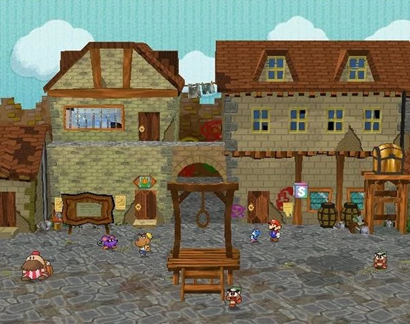
I just noose this was going to be a good game
The core gameplay mechanics behind THOUSAND-YEAR DOOR are nothing surprising. Like many RPGs, the combat is turn-based, in which the player can choose between certain regular, special, and ultimate moves in addition to a variety of items. Beyond this, THOUSAND-YEAR DOOR adds certain quirks to its fights, such as providing an audience during battles that will provide items and a recharge onto the ultimate attack gauge through the player’s precision in button pressing during attacks, or allowing a boss to pause a battle in order to have a quick conversation about dinner or their career trajectory if the player has certain items equipped. In much a similar way to SUPER MARIO BROS. 3, which begins by opening up the curtain and presenting the game as a performance, THOUSAND-YEAR DOOR calls back on styles and gags present throughout the Mario games up to this point.
Unlike other titles that rest squarely in the RPG genre, THE THOUSAND-YEAR DOOR holds no qualms in changing the gameplay at a moment’s notice. For instance, in between the chapters of the game’s story are intermissions that thrust players into classic 2D Mario platforming levels like in the original MARIO BROS., but this time from the perspective of Bowser himself. Furthermore, puzzles occur throughout the game at the same frequency as battles. These puzzles range from riddles that must be solved in a series of rooms to discovering the recipe for an invisibility potion, and in most instances, progression within the game is tied more heavily to solving the puzzles than to fighting a monster. This allows for periods throughout the game where combat grows nonexistent. During one chapter in the game, not a single enemy is present until two-thirds of the way through, and instead the player spends their time solving puzzles to discover a criminal hiding out on the train you both ride on. What this boils down to is that THOUSAND-YEAR DOOR uses RPG mechanics more so as a tool to alleviate any sense of tedium within the game rather than a crutch for the game to stand on.
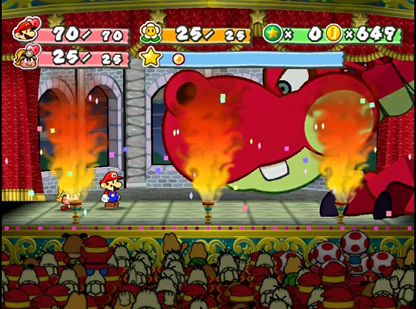
Mario: On Broadway
Where I find that THOUSAND-YEAR DOOR truly makes an impact is in its narrative and world design. In terms of narrative, where many games have stumbled with silent protagonists, this game capitalizes on Mario’s silence in favor of creating a bustling and boisterous series of sidekicks. Almost as if I was meant to feel like one of the supporting party members, the companions in this game make the comments that I was often thinking in any given scenario. Beyond the role played by companions, the villains, the quest-givers, and even the throwaway gag characters stand out. Many an RPG will litter its world with duplicate or distinctly inconsequential and unmemorable NPCs. THOUSAND-YEAR DOOR refuses to do this at every point, instead doubling down in providing each and every individual with a distinct personality of its own. From a shapeshifting ghost whose only weakness is his name, a mob boss with a deep love for his daughter, or a penguin detective who lacks any logical reasoning skills, each and every interaction feels like serious thought went into it.
As a whole, these townsfolk provide a lived-in feel to the world that Mario explores. Each specific locale stands out in its own right, but gains a degree of impact and significance as the game progresses and the player discovers the ways in which each area interacts and contributes to the environment of another. Discovering that a family living in a luxurious suburb is involved with a secret organization of bombs, or that a small child within the same family is deeply passionate about a battle arena discovered earlier in the game, influences the organic feeling and atmosphere of the world. Ultimately, these interactions foster a passionate connection between the player and the game which make playing the game so much more fun, and make completing the game such a tantalizing task.
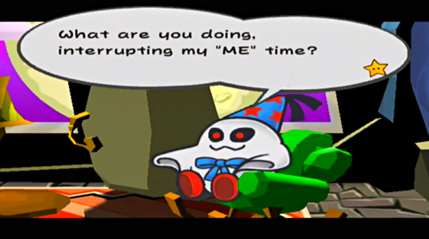
We’ve all been there at some point or another buddy
By interweaving the significance of the characters and world into the story and tailoring the gameplay mechanics enough to fit the style of the game, I believe THOUSAND-YEAR DOOR places itself into a standout and extremely memorable experience. Fans of Mario and RPGs alike will find something to sink their teeth into in this game just like I did, for instead of attempting to separate itself from the brand that makes it great, THOUSAND-YEAR DOOR distinguishes itself by capitalizing on the initial expectations players may have while simultaneously layering the story with depth and providing varied forms of gameplay that prevent boredom and promote the connection to Mario games across his entire franchise.
Mario is a household name for me and I’m sure many others. In the worst of times, he brings a fun and necessary escape from reality, and in the best of times, he revolutionizes gaming and personally gives me more friends. With PAPER MARIO: THOUSAND-YEAR DOOR, the cult following that has grown ever since the release of the game is just as incredible as the game itself. Nintendo outdid themselves with this game and it is no wonder to me that even to this day, 14 years later, fans still plead for the series to return to its roots. I don’t know if Nintendo will ever hear those pleas, but I can rest assured in knowing that PAPER MARIO: THOUSAND-YEAR DOOR will always be there for a trip down memory lane with some old friends.
PAPER MARIO: THE THOUSAND YEAR DOOR is available on GameCube



